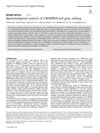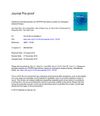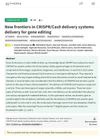Stimuli-Responsive Nanoformulations for CRISPR-Cas9 Genome Editing
August 2022
in “
Journal of Nanobiotechnology
”
CRISPR-Cas9 non-viral delivery systems pH-responsive cationic polymers redox-responsive delivery systems RNP-loaded nanoliposome androgenic alopecia SRD5A2 gene dermal papilla cells CRISPR non-viral delivery pH-responsive polymers redox-responsive systems nanoliposome hair loss SRD5A2 hair follicle cells

TLDR Advancements in nanoformulations for CRISPR-Cas9 genome editing can respond to specific triggers for controlled gene editing, showing promise in treating incurable diseases, but challenges like precision and system design complexity still need to be addressed.
The document reviews the advancements in stimuli-responsive nanoformulations for CRISPR-Cas9 genome editing, a technology with potential for treating incurable diseases. The focus is on non-viral delivery systems due to their better safety profiles. These systems can respond to specific triggers, such as biological cues and external stimuli, for controlled genome editing. The document discusses the use of pH-responsive cationic polymers and redox-responsive delivery systems. It also highlights studies that have used these nanoformulations for gene-editing, with efficiencies up to 26.4% in mouse models. External stimuli such as light, ultrasound, and magnetism have also been used for controlled genome editing. One study used ultrasound to deliver RNP-loaded nanoliposome for androgenic alopecia therapy, successfully knocking out the SRD5A2 gene in dermal papilla cells, improving cell survival. Despite promising results, there are still challenges that need thorough investigations, such as the precision in selective gene editing for disease treatment, the complexity of co-delivery of CRISPR-Cas9 components and donor DNA templates, and the need for advancements in nanotechnology and chemistry for rationalized system designs.








